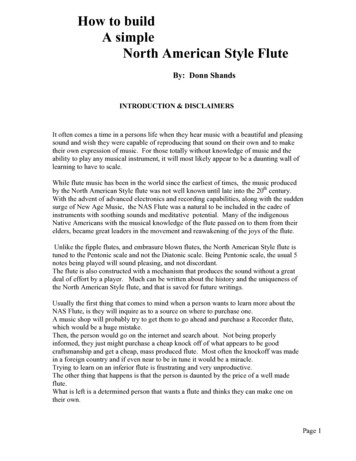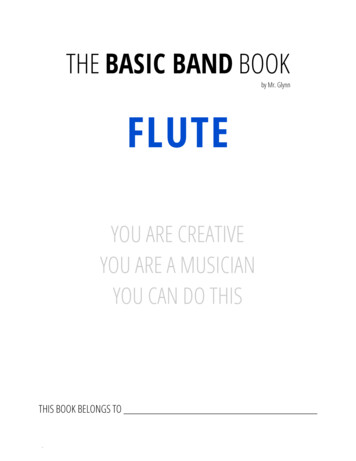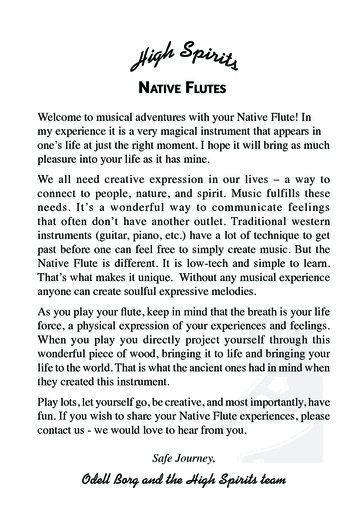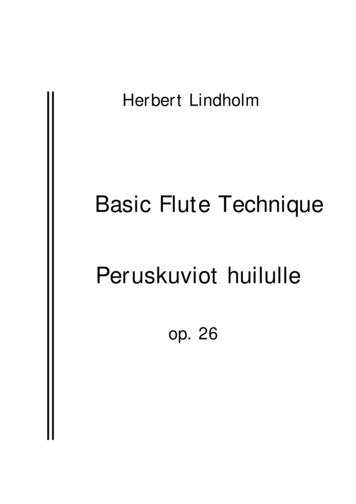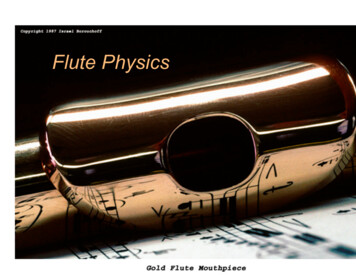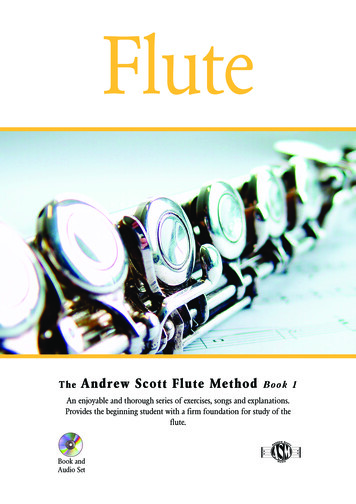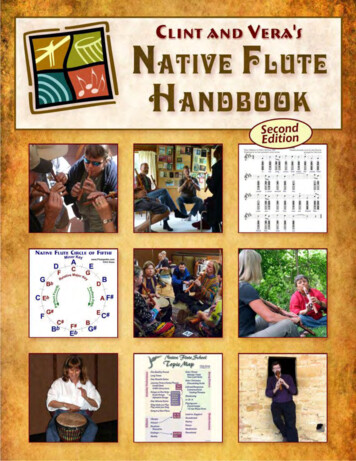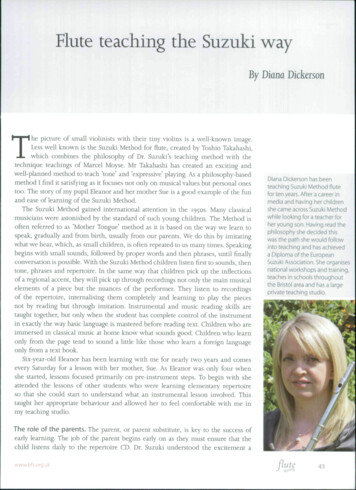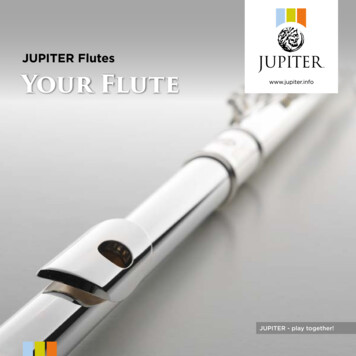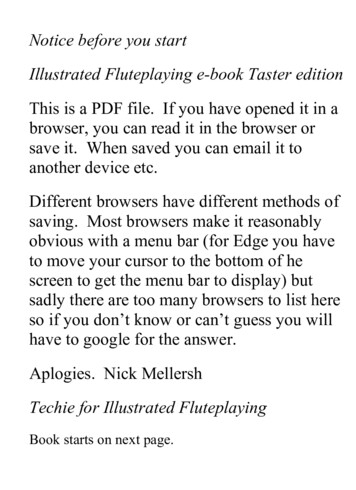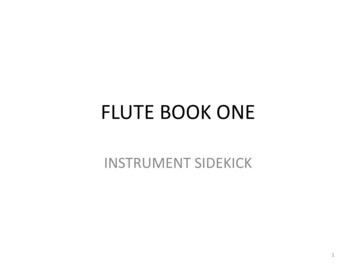
Transcription
FLUTE BOOK ONEINSTRUMENT SIDEKICK1
Opening the CaseOn a flatsurface.Handle isunderneaththeopening.Lifting thelatch.Uh oh! It will probably fall off Mr.Archie’s lap. It’s NOT a flat surface.2
First SoundPut finger inhead joint.Head JointBlow over the flute to the circle.See how long you can hold it.Can you ‘tongue’ a bunch of notes.3
Putting the Instrument TogetherHead JointMiddle JointLine up the tone hole withthe keys!4
Putting the Instrument TogetherFoot JointMiddle JointMake this rod point to the CENTERof the keys!5
The first finger wrapsaround like when you holda pencil.1No fingers on these2 keys!2Left Hand3Pinky over thiskey, but don’tpush it down.T‘T’ is for Thumb.Don’t pressdown this bigcircle key.6
Right HandPinkygoeshere.Skipthese 2keys!456PP is forPinky!Make hand like a ‘C’ andput your thumbunderneath to balance.7
Embouchure (Lip Muscles)Frown alittle.Blow over the flute,towards the circle.The tonguehits the topof yourmouth tostart EVERYnote. It’slike saying,“tooooo”,but withbreath, notvoice.Pretend this is a bowl of soup. Blowquick and cold air to cool it off.8
How To Sit1st: Sit up!Then: LegsTogether.This side is your Right Side!Not like this!Then: Moveyour kneesto the rightof the chair.9
How To SitTurn yourhead forward.Lastly: Bringyour arms up!Never bump the person next to you, never lean your elbows on the back of the chair,and never cross your legs.10
First Notes and SongsAGF1 Line Above StaffThe Space Above StaffT-123-PT-12-PAll 3 Never here. Addfor G AddAll 3for F1 23TThumb goeshere!4Not the bigcircle!Top Line of the StaffT-123-4-PHot Cross BunsA – G – F -- -- -A – G – F -- -- -FFFF GGGGA – G – F -- -- --Pinky goeshere.11
Keep Instrument Clean!Put a cloth through the hole.Two great examples of a cloth forflute are:HandkerchiefBandanaSwab out the inside of all 3 partsbefore you put it away:The Head JointThe Middle JointThe Foot JointOtherwise: It will SMELL!!!!12
More AGF SongsMary Had A Little -----Au Claire de la Lune -G-A-----G-----F-A-G-G-F----------All 3AGFThumbHave Friends HelpPinkyAsk friends to call out differentpatterns of A,G, and F. Then try toplay them back as fast as you can.Example:Friend: “FF GF AAFF!”You then try to play these notes inorder.13
Opposite NotesWhite Belt Test Page(From MEMORY during you NEXT lesson) Ready for a challenge: Do ya like CD’s?CD3rd Space Up4th Line UpT-23-4561-PFor C: Press the square keys, and keepfingers hovered over the circle keys.For D: Press the circle keys, and keepfingers hovered over the square keys.14
Time For Practice!! How fast can you go back and forth between ‘C’and ‘D’? Want to get faster? The trick is to do it over and over, as many timesas you can. The 2nd trick is to do it at least a little bit EVERYDAY!! If you forget to do it for a day, you mightget slower. When you can do it fast for Mr. Archie, he’ll checkthe box off at the top right. (Or maybe put a StarWars stamp)15
New Goal!!!! Speed tests!!C to F to CC to G to CC to A to CD to F to DD to G to DD to A to D16
CD-FGA Songs Practice these: (Do them over and over everyday to show off in lessons.)Swing Low, Sweet ChariotA-F-----A-F---F-D-C------F-F-F-F-A-A-(High C)(High ------Amazing AFA------G-(High C)--------A-(High C)(High -G-F-----------------17
2 More Notes!!!!!!EbBbMiddle Line WITH a flat sign.T-1—4---PHint: It’s just like ‘F’, but withyour 2nd and 3rd fingers up.Top space WITH a flat sign.T-23-456-PHint: It’s just like ‘D’, but withthe pinky down.Flat Sign!You HAVE TO sayflat whendescribing thesenotes. A ‘B’without the flat isa different notewith differentfingerings.18
More Practice! Speed Test 2!Bb to C to D to Eb to FF to Eb to D to C to BbBb to D to FF to D to BbC to Eb to GG to Eb to C19
It’s Holiday Time!!Yellow Belt Test Page! Play these Holiday Tunes!Jingle -------Good King -----Dreydle Eb-C-Eb-C-------CF-Eb-D-C-Bb---------(Repeat)20
It’s Time To Learn To Read Music! What is this called? How about this one?What is a beat?How do we keep track ofbeats?And this one?What does it mean?21
Count To 4 (But In Your Head) On any note practice: Eighth 4and1and2and3and4andCount the numbers in your head!These arethe beats!Tap themeach withyour foot.These arethe upbeats!So your footmust be UP!BAR LINES DIVIDE THEMEASURES!!!!Think a number whenyou step down.Think “and” whenyour foot goes up.22
A Little Easier .Quarter NotesJust count to 4 and tap your feet for each note.Foot Stompin’ Test!!!12323
First Time ‘Reading’ A SongBile Them Cabbage DownTitleComposerTraditionalFlats last a whole measure, so theysave space and ink.Double Bar means youended the song.Can you read the rhythm? Look back to the earlier pages in thebook if you forgot how to read the notes. Never write them in!!This is the test page for OrangeBile Them Cabbage DownBelt!TraditionalThis is a ‘repeat sign’. Go back to the beginning and play 124more time.
Longer and Longer RhythmsHalf Notes Get 2 Beats1 23 4tooooooo toooooo123412341234Whole Notes Get 4 Beats!!1 23 4tooooooooooooooRhythm And Foot Test!!!1234New note! High Bb. It has the samefingering as regular Bb, but blowcolder air.1234123425
Old Songs, But How They Really Look!Remember, do NOT write in the names of the notes!Good King WenceslasAmazing GraceJohn M. NealeJohn NewtonPoint of ‘Note’: John Newton wrote the music, but William Walker wrote the words.High C26
New Songs: Can Ya Figure Them Out?Shoo FlyPolly Wolly DoodleAmerican Folk SongAmerican Folk SongA dotted half note is 3 beats!This is low ‘A’. You play it just like the normal ‘A’, but blow slower, warmer air.27
How Do We Know When NOT To Play?NOTES1RESTS23412What’s Their Name?3412341234123412341and2and3and4and1 and 2 and 3 and 4 and28
The ‘Rest’ of the Songs You AlreadyKnowWhat are the names ofthe songs?29
And What’s This?Test page for Green Belt!This is a Key Signature. They put all the flats for the B’s and E’s over there.What’s a Time Signature do again?What’s the name of this song?What are the names of the different notes and rests? Did you keep the beat with yourfoot the whole time?30
New Songs!!!!The Can CanJacques OffenbachHow many beats are per measure with this Time Signature?Frere JacquesFrenchAsk your really amazing awesome teacher to explain how to do this as a round!!31
Slurs and TiesI Want Chocolate CakeTest page for Blue Belt!This means to “slur”. Switch to the different notes WITHOUT ‘tonguing’.Practice MoreAllen T. ArchieThis is a “tie”. Keep blowing withoutputting space, or tonguing the newnote.Allen T. ArchieThis is a‘DUET!’.Ask Mr.Archie howIt works!What’s the difference between a tie and slur?What’s the same?32
Major Scale: Bb AND Concert BbDotted 8th – 16thWhat song does this end with?Dotted Quarter Noteand 8th1234 andRemember downbeats and upbeats?This is the test page for Purpleduring the next lesson.Belt. It must be done from memoryTry to do it from MEMORY!!!!!!33
Mapping-1Steven FosterCamptown RacesStart:How Much Is That Doggie In The WindowBob Merrill and Ingrid Reuterskiold1 2 3Pick Up Note!1st and 2nd Endings!Repeats. Dots bounce ya back,and dots catch you.34
Mapping-2BeethovenOde to Joy“Finish” here the 2nd time.TraditionalPaw Paw PatchLow FD.S. and D.C. al Fine or Coda are usually used for larger distances in the music.D.S. goes to the weird looking ‘S’ sign (called segno). D.C. goes to the beginning.35
Volume Dynamics Dynamics actually refer to ‘intensity’. BUT how intense you play affects the ‘loudness’ ofyour sound. The following is a good beginning:– F Forte strong– P Piano flat, level– Crescendo Cresc. growing– Diminuendo dim. decresc. diminish36
ExamplesTraditionalBaby BumblebeeRichard StraussAlso Sprach ZarathustraThis is ‘Ab’. See next page for fingering.Happy BirthdayFermata Hold the note.TraditionalRitardando Gradually slow down.37
New Notes and Key Signatures Ab (Low and High): T-123(p)- P– So it’s just like ‘G’, but with your left hand pinky– If B’s, E’s, and A’s are flat, the key signature looks likethis: E natural (or just ‘E’ without the flat):– T-123-45-P (Like F, but add the 5th finger)– If only B’s are flat, the key signature looks like:– If the key signature has Eb’s in it, and they want an Enatural in the piece, they’ll use a ‘natural’ sign:38
2 New ScalesThis page is the test for Red Belt.(It must be done from memory during your next lesson.)F Major ScaleEb Major ScaleE naturalAbCan you play “Joy to the World” with these scales?39
Italian: The Language of Music Largo: Broad, wide. (Really slow)Andante: To go, walk. (Kind of slow)Moderato: Moderate. (Medium speed)Allegro: Cheerful, bright. (Kind of fast)Vivace: Lively, vivid. (Pretty fast)Presto: Quickly, quick. (Extremely fast)40
Fingerings Bb (Low and High): T-1—4—PC (Low and High): 1---------PD (Not High): T-23-456Eb (Not High): T-23-456-PE (Not High): T-123-45—PF (Low and Normal): T-123-4—PG (Low and Normal): T-123---PAb (Low and Normal): T-123(p)---PA (Low and Normal): T-12----P41
Brown and Black Belts Mr Archie will give you blank staff paper(called manuscript paper) to compose a songwith. There will be a rough draft. Mr. Archiewill make suggestions. Re-write to a finaldraft. If Mr. Archie can play it as it shouldsound, then you pass for Brown Belt. Mr. Archie will give you a full page solo thatneeds to be learned and performed in lessonsfor Black Belt.
Is there more? Black Belt – 1st degree (2 BB’s tied together):Having attended NYSSMA. Black Belt – 2nd degree (3 BB’s tied together):Achieving a score high enough to be asked to a UE Recital called the Crawford Stahl Recital. Black Belt – 3rd degree (4 BB’s tied together):Achieving the top score at the Crawford StahlRecital. Book II: Mr. Archie is in the process of writing thisbook. If one exists for your instrument, you canbegin the work towards “Twisty Belts”!
Blow over the flute to the circle. See how long you can hold it. an you tongue [ a bunch of notes. 3 . Putting the Instrument Together Middle Joint Head Joint Line up the tone hole with the keys! 4 . Putting the Instrument Together Foot Joint Middle Joint Mak
